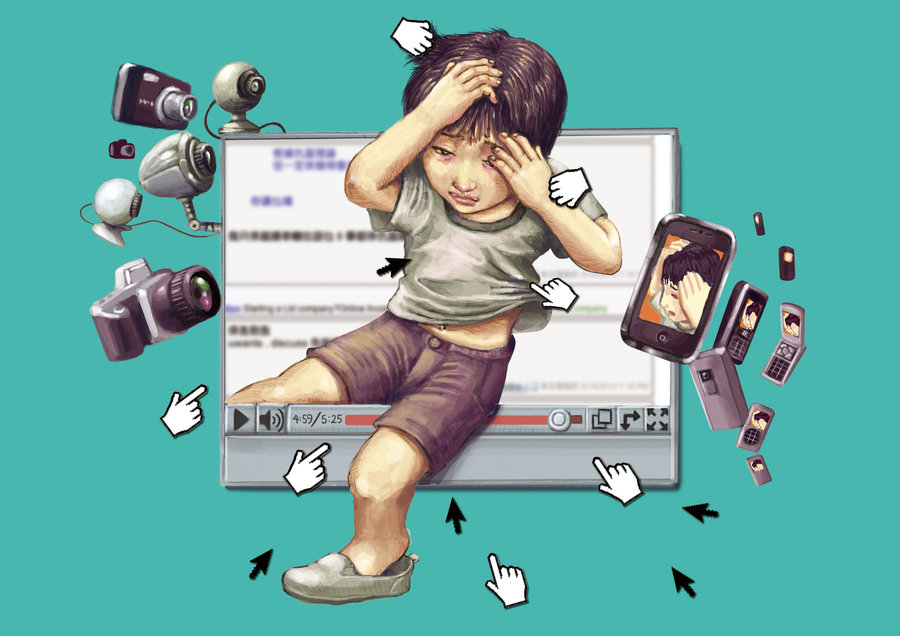The internet has been the biggest achievements of human civilization. However, with its advent cyber crimes have risen, particularly voyeurism, making the governance of internet more important than ever.
Since, the beginning of civilization humans have improvised their living standards and to be more specific improvised technology in order to secure a developed future. This has led to major advances with the ‘internet’ being the most tremendous advancement in the history of humankind. Internet places the power to access any kind of information in the hands of anyone having a simple computerized/telephonic connection. In this sense, Internet is anarchic but at the same time it is governed by certain governmental systems and laws, thus contradicting its own-self. The internet has been a revolutionary advancement but with its own cons. The misuse of internet is why the laws need to govern it, the forgery committed through it is why the anarchic development needs to be taken care of and the acts, which disrupt the peaceful life of others need to be penalised. These laws are known as cyber laws.

VOYEURISM:
One of the gravest and the most popular crime in the cyber world that we know of is ‘voyeurism’. The meaning of voyeur is “a person who gains pleasure by secretly observing other’s sexual acts” 1. With the advancement in video making and picture capturing technologies, the act of voyeur has become much easier and common. Voyeurism is an act that blatantly defies all the reasonable expectations of privacy in an individual’s life. It is a criminal offence to both the privacy and the dignity of an individual. It controls the autonomy of a person to expose or not to expose their body or any kind of sexual act they do without their consent or knowledge, either through unwarranted observation of the individual, or through distribution of images or videos against the wishes or without the knowledge of the victim2. With this also comes the concept of revenge porn, which refers to sharing private/sexual images of a person in order to defame and humiliate the person. The only difference is that the sexual/intimate pictures might be procured by voyeurism or through consent.
Video voyeurism is one of the most rampant crimes that confront us today. Security and assurance of privacy is one of the most sensitive issues in the gamut of cyber world. As the internet rapidly becomes a part and parcel of our life, it becomes clear that violation of privacy is not limited as a threat to the dot coms and individuals but the whole internet community at large. While the foreign countries are well versed with the concept and have a variety of statutes to regulate and control the same. India, influenced by the section 1801 of the “Video Voyeurism Prevention Act” of 2004 – a law of the United State of America dealing with the crime of voyeurism, introduced section 66E vide the Information Technology Amendment Act, 2008, which came into force in October, 2009.

WHAT IS SECTION 66E?
The section 66E of the IT Act, 2008, recognizes the right of privacy as inviolable and makes the violation of the same punitive with imprisonment or fine (not exceeding the amount of 2 lakhs) or both. The section recognized desire of privacy as a respectable one, particularly in our society recognising the cultural ethos and the values we espouse, it also deserves legal protection. The section 66E of the IT Act, 2008, implements the right to protect the human body from unreasonable and involuntary obscene intrusion and protects the individual’s privacy from crimes such as voyeurism, which destroys the dignity and privacy of an individual.
Furthermore, apart from the section 66E, there are some other legal provisions in the IT Amendment Act, 2008 ensuring the inviolable right to privacy, specified below:
- Section 67 of the IT Act: The section states whoever publishes or transmits obscene content into an electronic form. The section also mentions that if a camera captures any obscene electronic information, the owner of the camera can be booked under this particular section, but if the camera specifically captures any sexually explicit content, it will be classified as a non-bailable offence u/s 67A entailing imprisonment and a fine.
- Section 67A of the IT Act: The section provides non-bailable punitive measures for publishing or transmitting any sexually explicit content in electronic form. The ultimate reason to implement this section is to make Indian mobile and laptop users extremely careful whenever they click a picture or record a video of a sexually explicit act or conduct. Failure of which shall result in an imprisonment of 5 years and a fine of Rs. 10 lakhs.
- Section 79 of the IT Act: The section privatizes censorship in India. It also exempts the liability of the intermediator in some cases such as third party information of links to some information being provided to some other party except of course conspired by the intermediary itself.
The Information technology Amendment Act, 2008 has been an epoch making legislation providing the seriousness against cyber crimes in the country, aligned to which the government has had a two pronged approach: Enforcement measures under the laws and secondly the governmental approach i.e. rules and guidelines regarding cyber security. Some of the governmental approach regarding cyber security are mentioned below:
- Indian Computer Emergency Response Team (ICERT): According to section 2(iia) of the IT Act, 2000 “Indian Computer Emergency Response Team” means an agency established under sub-section (I) of Section 70-B.3
- Attempt is an offence (S. 84-C) inclusion of this offence under the IT Act would be useful as while trying at the computer, like vandalising the data, hacking, in this condition, the accused can be punished for attempt to commit the crime in question.4
- Critical Information Infrastructure (CII), Section 70(I) defines the term “Critical Information Infrastructure” means the computer resource, the incapacitation or destruction of which, shall have debilitating impact on national security, economy, public health or safety.
- Protected System, Section 70(I) (Amended) defines the term “Protected System” has been enlarged to bring within its ambit the CII.
- National Nodal Agency, Section 70-A, to ensure cyber security in the country there is provision for the establishment of National Nodal Agency.
- Monitoring, interception and decryption of data- Section 69(Section 69 of IT Act, 2008 provides direction for interception or monitoring or decryption), 69-A (Provides blocking for public access, 2008) and 69-B (Provides monitoring and collecting traffic data, 2008), empowers the government to authorise any agency to take these steps as per the rules prescribed by the government. The Information Technology (Procedure and Safeguards for Monitoring and Collecting Traffic Data or Information) Rules, 2009.5
With the recent times of development in the IT Sector and recognition of cyber securities and personal space, for the first time in 2013, the Indian Penal Code accepted Voyeurism as an offence u/s 354C vide Criminal Law Amendment Act, 2013, which states that sexual voyeurism is one of the type of sexual harassment. The section clearly states that who have been watched, or recorded, without their consent and under circumstances where the victim could reasonably expect privacy, and where the victim’s genitals, buttocks or breast have been exposed, the offender will be punished.6
The right to privacy, its violation through various forms one of which being voyeurism and safety of women are intricately linked in any legal system. If any legal system does not protect the privacy both of the body and the information of its people, there will always be insecurity in such a system. With the recent debates on women’s safety and personal choice, several crucial privacy and security issues have been raised, such as the criminalization of voyeurism and stalking. Hopefully, the demands for autonomy and protection of privacy will continue to be raised in the future.

By and large instances of voyeurism are occurring in India because of the inherent defects in the existing law of India. One of the biggest tragedies as far as the legislations in independent India is concerned, is that India does not have a dedicated system to protect the privacy of its citizens. It can be said that the system i.e. the state never wanted to provide complete privacy to its citizens in order to control and manipulate. However, the educated masses well aware of their rights demand protection of their rights, voice their opinions and revolutionize the existing system. Thus creating new rights and a new law to ensure their safety.
It is ironical that even after 70+ years of freedom, the individual fights for its own liberation and a personal space. It is high time we start educating ourselves and voice for change. Let the concept of justice prevail!
Pearl Sharma is a student pursuing Law.
References:
- Prof. Walker MB. Chamber’s Dictionary of Science and Technology, Ed. 4, Allied Chambers, New Delhi India. 2001.
- Available at http://www.mightylaws.in.
- Inserted by S.36 of the IT (Amendment) Act, (10 of 2009). The central government shall make arrangements for the establishment of a central entity to serve as ICERT. This will be a specialized body primarily to take care of the protected system in the country, 2008.
- Inserted by S. 45 of the IT (Amendment) Act. Attempt is defined under S. 511 of IPC as a punishable offence, 2008.
- Vide G.S.R. 782 (E), 2009.
- The Criminal Law Amendment Act, DL (N) 2003-13, Ministry of Law & Justice Legislative Department, 2013.
edited by: Maryam Ahmed
Disclaimer: The opinions expressed in this publication are those of the author. They do not purport to reflect the opinions or views of The Jamia Review or its members.



GIPHY App Key not set. Please check settings